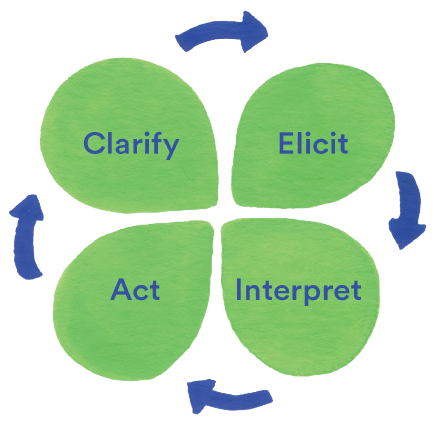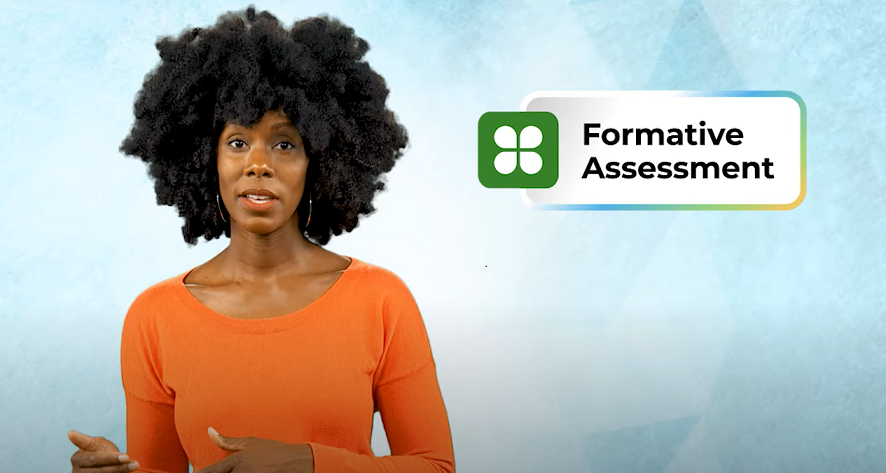Purpose
Formative assessment, or assessment for learning, is a set of instructional practices used to monitor student learning to provide ongoing feedback that can be used by educators to improve their teaching and by students to improve their learning. It is a vital component of a district’s balanced assessment system because it is continually operating in a learning environment to move students forward in their learning.
The Council of Chief State School Officers (CCSSO) published this definition in 2018:
“Formative assessment is a planned, ongoing process used by all students and teachers during learning and teaching to elicit and use evidence of student learning to improve student understanding of intended disciplinary learning outcomes and support students to become self-directed learners.
Effective use of the formative assessment process requires students and teachers to integrate and embed the following practices in a collaborative and respectful classroom environment:
- Clarifying learning goals and success criteria within a broader progression of learning;
- Eliciting and analyzing evidence of student thinking;
- Engaging in self-assessment and peer feedback;
- Providing actionable feedback; and
- Using evidence and feedback to move learning forward by adjusting learning strategies, goals, or next instructional steps.”
Formative Assessment Process
The formative assessment process can be simplified as a four-leaf clover where each leaf represents one dimension of the process. Click the picture on the right to view a short video from Smarter Balanced about the formative assessment process. Below the image, each dimension is explored in more detail. Oregon’s Statewide Assessment System (OSAS) includes several online tools in support of the formative assessment process.


What does this mean?
- Determine Learning Goals, or what students will know by the end of the lesson. Goals describe “big ideas” or concepts and reflect academic standards. Learning goals are written in student-friendly language, beginning with, “I understand...”
- Establish Success Criteria, or the evidence teachers and students use to determine how students are progressing toward learning goals. They are also written in student-friendly language, beginning with, “I can...”
Things to consider:
- Use the Backward Design process, through which instructional activities and strategies are framed around these learning goals.
- Use a learning progression rather than just grade-level standards to plan instruction. Achieve the Core’s Coherence Map Tool helps connect concepts and skills across grade levels.
- While learning goals typically center around the concepts and skills of standards, success criteria can embed components of SEL. Some examples include:
- I can ask a question of a classmate.
- I can identify when I feel “stuck” and can choose from my list of tools one way to get “unstuck”.
-
I can connect with a family member or friend and describe one big idea I learned today.
What does this mean?
- Engage in a learning event or activity that prompts and generates evidence of learning. Evidence should be tightly aligned to the learning goals and guided by success criteria.
- Consider student needs, interests, and learning styles when deciding how to elicit evidence so that students can demonstrate their understanding in different ways to meet the success criteria. Use multiple sources of evidence to draw accurate conclusions about student learning.
Things to consider:
- Intentionally engage students with tasks or activities that require them to show their thinking. Limit or avoid tasks that require only an answer without an opportunity to explain thinking or connect concepts.
- Use the Smarter Content Explorer or Sample Items Database to find and adapt tasks that are aligned to learning goals and standards.
- Quality tasks matter more than quantity of tasks.
- Try out some of the 56 Ways to Gather Evidence of Student Achievement
-
If the criteria for success are clear as guardrails, students should have agency to determine how they show what they know and can do.
What does this mean?
- Review evidence to determine students’ progress toward learning goals and success criteria. Interpreting is about using evidence to identify the gap between where students are and where they need to be.
- Students can analyze evidence of their own learning and discuss with teachers and peers.
- Interpreting evidence is not a single event, but part of an ongoing process throughout instruction.
Things to consider:
- Interpreting evidence is a valuable skill for students’ post-secondary readiness and often aligns to specific standards and practices. Teaching students to interpret evidence is worth the instructional time investment.
- Rubrics often make this interpretation easier and more consistent. A number of online tools exist to quickly create rubrics.
- While much of this interpretation happens “on the fly,” educators must anticipate student thinking as part of their planning process.
- What questions might unlock student thinking?
- What whole-class discussion might need to happen, and with what focus?
-
Are examples and artifacts of student work needed?
What does this mean?
- Teachers determine and initiate appropriate instructional next steps. These may not be the same for all students and must take into consideration each student’s readiness, interests, and learning preferences.
- Students receive feedback that is specific about what they need to do next in the learning process.
Things to consider:
- A positive, collaborative culture must be in place between educators and students for feedback to be most meaningful and effective.
- Students must receive feedback that is descriptive, actionable, and timely.
- Utilizing peer feedback routines can substantially increase the amount of feedback each student receives.
- A number of online tools make verbal and video feedback easy to give and receive.
Tools for Teachers is a collection of digital resources that supports K–12 teachers in their use of the formative assessment process to adjust teaching to improve student learning. Tools for Teachers features:
The instructional resources in
Tools for Teachers are developed, submitted, and reviewed by members of the State Network of Educators. The State Network of Educators consists of educators from Smarter Balanced member states, including Oregon.
Tools for Teachers Resources:
For more information about Formative Assessment, please contact the ODE Assessment Team.